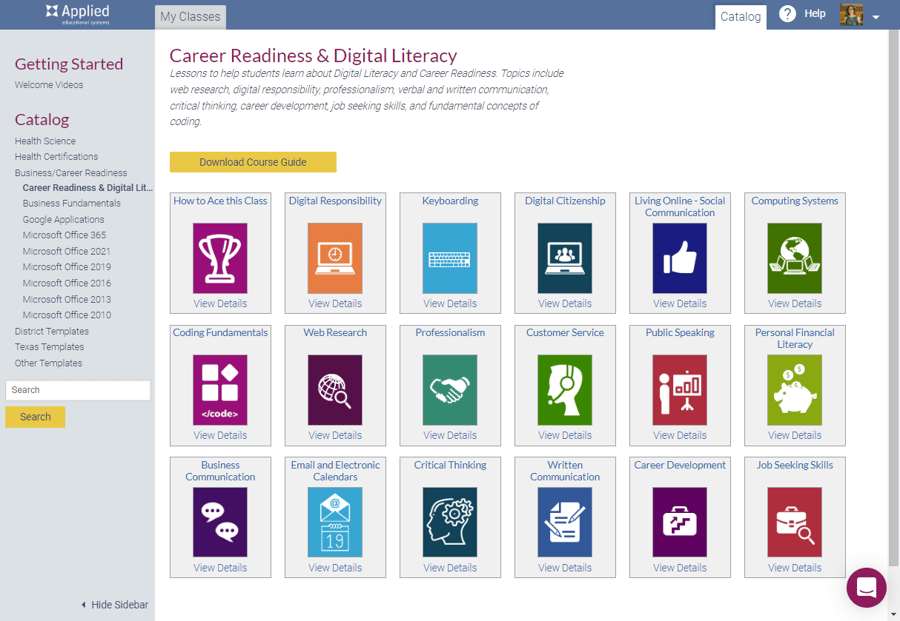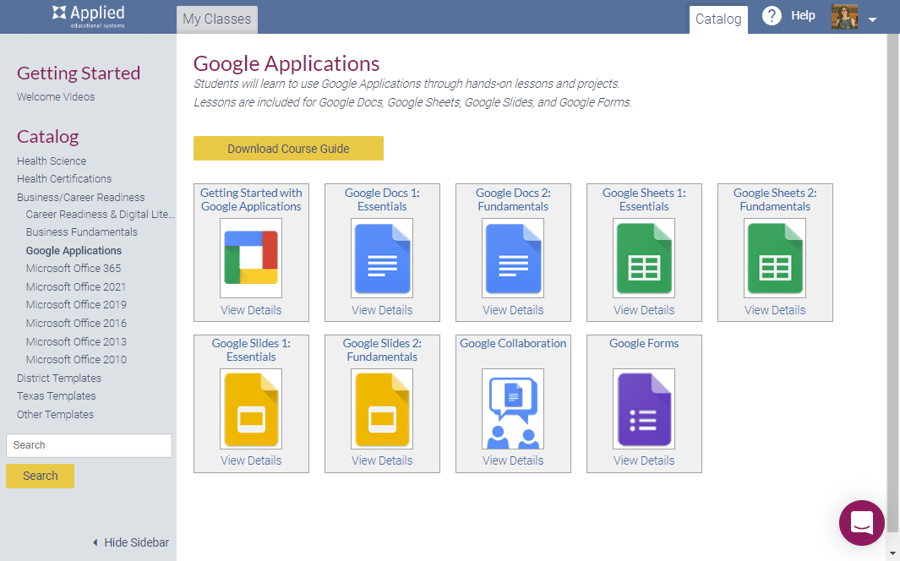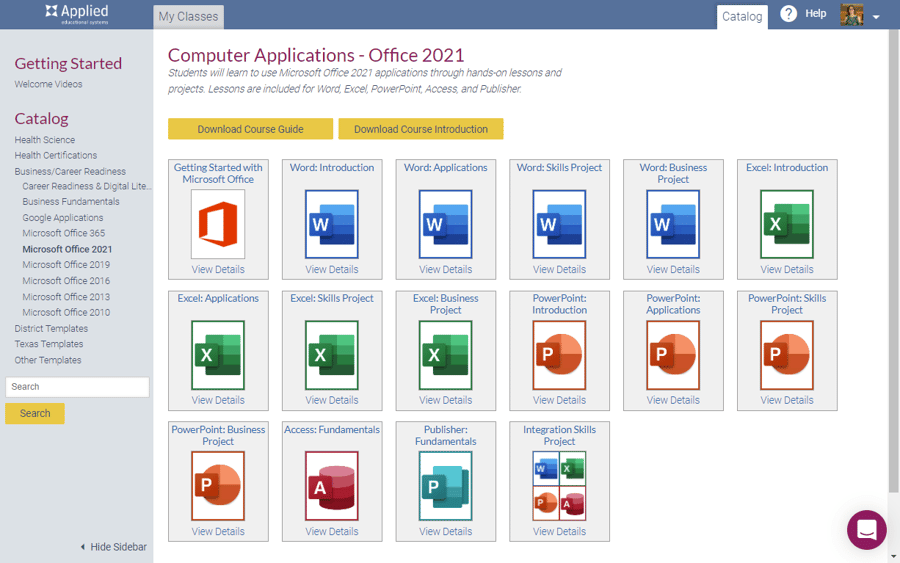Computer Applications | Google Apps | Business&ITCenter21 | Microsoft Office
What Computer Applications Topics Can I Teach with AES?
With past experience in teaching, a couple of degrees in writing, and an upbringing immersed in medical jargon, Mike is positioned well to hear out the most common questions teachers ask about the iCEV curriculum. His goal is to write content that quickly and effectively answers these questions so you can back to what matters - teaching your students.
Computer applications teachers often come to AES feeling overwhelmed by their responsibilities. Between meeting course standards, engaging classes, and prepping students for certifications, teachers like you have a lot on your plate.
Luckily, our computer applications curriculum is flexible and comprehensive enough to handle most of these problems for you. But will it cover the topics you need it to? Is it the right choice for your class?
After all, depending on what kind of technology course you teach, some modules and lessons will better fit you than others. Knowing what modules are out there and which ones will best suit your class will save you time as you determine whether AES is a good fit for you.
In this article, you’ll discover what computer applications subjects you can teach with Business&ITCenter21:
- Digital Literacy and Citizenship
- Google Applications
- Microsoft Office
By the end of this article, you’ll have a better sense of each of these subject areas as well as what Business&ITCenter21 modules can be used to teach them.
1. Digital Literacy and Citizenship

Many computer teachers are required to teach digital literacy and citizenship to equip students with the skills and knowledge necessary to successfully navigate the digital world. In these classes, students learn best how to secure personal information, communicate with others digitally, use social media responsibly, and more.
If you need to teach these concepts to middle school or high school students, Business&ITCenter21 can serve as an effective foundational curriculum.

Altogether, Business&ITCenter21 has 83+ hours of curriculum content dedicated to teaching digital literacy and citizenship. Some of the best modules to help you teach these topics include:
- Digital Responsibility - where students learn best practices for avoiding digital distractions and why it’s important to stay on task and complete their work.
- Keyboarding - where students learn proper posture and the functions of each of the rows of a keyboard, while also gaining typing skills via practice games and activities.
- Digital Citizenship - where students learn about how to safely and effectively use the internet via concepts like digital footprints and cyberbullying.
- Living Online and Social Communication - where students follow an engaging narrative that teaches them more about social media and safe smartphone use.
- Computing Systems - where students learn foundational knowledge about computing, including software, data storage, network computing, and how to use computers safely.
- Coding Fundamentals - where students learn the basics of computer science and coding, including completing simple coding tasks and activities.
- Web Research - where students learn how the internet works, where to go to find reliable sources of information on the web, and evaluate the sources they find.
- Email and Electronic Calendars - where students learn practical knowledge surrounding email and calendar applications that they’ll use to organize their lives.
These modules will help you introduce your students to essential digital concepts and skills. After you’re done teaching, your students will have a firm grasp of the digital world, and will be more equipped to handle technology in their personal and professional lives.
Because the AES curriculum is built for flexibility, computer teachers often incorporate these modules alongside both our Google Applications and Microsoft Office content. After all, no matter whether you teach Google, Microsoft, or both, giving your students a solid understanding of technology is often an essential first step.
Need more information on how AES can help you teach digital literacy? Check out this digital literacy course guide for a more in-depth look at what modules you need.
2. Google Applications

Google Applications courses are designed to teach students the fundamentals of apps like Google Docs, Google Sheets, and Google Slides. With their focus on collaboration and group work, these applications play a key role in the changing landscape of the workplace. It’s no wonder, then, that many computer teachers want to get their students off to a strong start in learning them.
If you teach a Google Applications course, or even just a Google Apps unit, then Business&ITCenter21 will serve well as a core curriculum so your students can learn the essentials.

All in all, Business&ITCenter21 has 65+ curriculum hours dedicated to teaching Google Applications. Some of the best modules to teach this subject include:
- Getting Started with Google Applications - where students are introduced to each Google App, gaining an overview of both the general interface and Google Drive.
- Google Docs 1: Essentials - where students explore the basics of Google Docs, learn how to open and save files, enter text, and use review tools.
- Google Docs 2: Fundamentals - where students gain a more in-depth view of Docs, including how to format documents, work with tables, and complete a report using MLA guidelines.
- Google Sheets 1: Essentials - where students learn the basics of Google Sheets, including rows and columns, selecting cells, entering formulas, and formatting data.
- Google Sheets 2: Fundamentals - where students learn more advanced functions in Sheets, including relative/absolute cell references, changing cell formats, adding cell borders, and more.
- Google Slides 1: Essentials - where students are introduced to Google Slides and its tools, including templates, themes, text boxes, shapes, word art, and more.
- Google Slides 2: Fundamentals - where students learn more advanced concepts in Slides, like how to create better presentations, use charts and graphs, define hyperlinks, and more.
- Google Collaboration - where students learn how to use the cooperative functions within Google Applications to work together to complete documents and presentations.
- Google Forms - where students learn how to create and analyze Google Forms in order to create polls and quizzes for their classmates.
It’s important to remember that many of these modules come with engaging activities and projects intended to help students solidify their understanding of each Google Application.
Altogether, these modules provide students with fundamental Google Applications knowledge that they can carry forward into their careers. Not only do they learn the basics of each Google App, but they also take the extra step to complete assignments that grant them practical skills.
Need more information on what Google Applications topics you can teach with AES? Read this Google Applications course guide for more detail on the modules you want to use.
3. Microsoft Office

Microsoft Office courses are intended to teach the most important applications of the Microsoft Office Suite, including Word, Excel, and PowerPoint. For decades, Office has been the primary computer application suite used in businesses and classrooms across the country, which makes it essential for students to learn.
If you teach a Microsoft Office course or unit, or are otherwise trying to help your students earn MOS certifications, then Business&ITCenter21 is an excellent choice of curriculum that will suit your needs.

All told, Business&ITCenter21 has 109+ curriculum hours of Microsoft Office 2021 content to help you teach your course, though it also offers similar amounts of content for Office 2016, 2019, and 365. Divided by application, some of the best modules you can use to craft your course include:
Microsoft Word Modules
- Microsoft Word 1: Introduction - where students learn the basics of Microsoft Word, like how to open files, enter and format text, use review tools, and more.
- Microsoft Word 2: Applications - where students learn more in-depth functions in Word, like how to format paragraphs and documents, use tables, and cite within MLA guidelines.
- Microsoft Word Skills Project - where students develop their Word skills by drafting a document based on a research topic they choose. Along the way, they revise their manuscript, use lists and tables, and eventually publish it as a PDF.
- Microsoft Word Business Project - where students apply their Word skills to create a job description booklet for a fictional employer, along the way creating templates, a cover page, and a table of contents.
Microsoft Excel Modules
- Microsoft Excel 1: Introduction - where students learn the essentials of Microsoft Excel, including cells, columns, rows, data entry, functions, cell references, and more.
- Microsoft Excel 2: Applications - where students learn more advanced Excel functions and skills, like conditional formatting, sorting on multiple criteria, and data management.
- Microsoft Excel Skills Project - where students apply their newfound Excel skills to import and process raw data, create graphs and analytical charts, and eventually export their findings to PDF printouts.
- Microsoft Excel Business Project - where students apply their Excel skills to process business data, including performing financial analyses and calculating net income.
Microsoft PowerPoint Modules
- Microsoft PowerPoint 1: Introduction - where students learn the fundamentals of Microsoft PowerPoint, including slides, themes, text boxes, and templates.
- Microsoft PowerPoint 2: Applications - where students learn more advanced PowerPoint skills, like how to use links, art, and graphs to make more effective presentations.
- Microsoft PowerPoint Skills Project - where students showcase their PowerPoint skills by developing a presentation on a topic of their choice, including adding text, images, transitions, and more.
- Microsoft PowerPoint Business Project - where students apply their PowerPoint skills to create a presentation for a company that they’ll show at a fictional job fair.
Additional Microsoft Modules
- Getting Started with Microsoft Office - where students gain an overview of Office 2021, the various applications that compose it, and common features they share.
- Microsoft Access Fundamentals - where students learn the basics of Microsoft Access, including datasheets, databases, forms, tables, queries, and more.
- Microsoft Publisher Fundamentals - where students learn the essentials of Microsoft Publisher by creating several documents, including a calendar and bookmark.
- Microsoft Integration Skills Project - where students create a budget, proposal, and presentation for a company picnic in order to learn to share information between Office applications and use them in coordination with one another.
Similar to AES’ Google Applications content, these Microsoft Office modules serve as an excellent source of foundational knowledge for students. What’s more, they help students develop the practical knowledge and skills to handle most situations they’re likely to encounter in the workplace.
Because of this, Business&ITCenter21 works particularly well to prepare students to earn MOS certifications, especially when paired with test prep materials like GMetrix. Business&ITCenter21 provides students with essential knowledge, while the test prep materials help them directly review what they’ve learned to prepare for the exam itself.
Need more detail on how to teach Microsoft Office with AES? Read the Microsoft Office 2021 course guide for a more in-depth look at the modules you should use.
Start Teaching Computer Applications with AES
In this article, you’ve discovered the most prominent computer applications subjects that Business&ITCenter21 can help you teach. If you need material to cover digital literacy, Google Applications, and Microsoft Office, then this curriculum system will serve you well.
However, if you’re like most computer applications teachers, you probably need to teach a mix of all three of these subjects in your classroom. With its high level of flexibility and modularity, Business&ITCenter21 is well-equipped to do just that.
Each of the modules within Business&ITCenter21 can be combined with any of the others so that you can craft the perfect curriculum to fit your course. So if you need to teach a bit of Google Applications, a bit of Microsoft Office, and even some career readiness or business education topics, Business&ITCenter21 may be the right choice for you.
If you’re interested in trying Business&ITCenter21 for your computer applications course, start a free trial. This trial gives you complete access to the Business&ITCenter21 catalog, so that you can mix and match all of its modules to develop the perfect curriculum for you:


